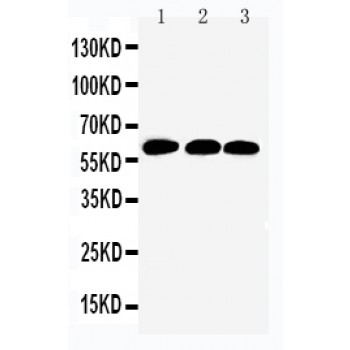More info
Overview
Long Name | Antibody Type | Antibody Isotype | Host | Species Reactivity | Validated Applications | Purification |
| SMAD family member 4 | Polyclonal | IgG | Rabbit | Human, Mouse, Rat | IHC-P, WB | Immunogen affinity purified. |
Immunogen | ||||||
| A synthetic peptide corresponding to a sequence at the N-terminus of human Smad4(97-113aa RLWRWPDLHKNELKHVK), identical to the related rat and mouse sequences. | ||||||
Properties
Form | Lyophilized |
Size | 100 µg/vial |
Contents | Antibody is lyophilized with 5 mg BSA, 0.9 mg NaCl, 0.2 mg Na2HPO4, 0.05 mg Thimerosal and 0.05 mg NaN3. *carrier free antibody available upon request. |
Concentration | Reconstitute with 0.2 mL sterile dH2O (500 µg/ml final concentration). |
Storage | At -20 °C for 12 months, as supplied. Store reconstituted antibody at 2-8 °C for one month. For long-term storage, aliquot and store at -20 °C. Avoid repeated freezing and thawing. |
Additional Information Regarding the Antigen
Gene | SMAD4 |
Protein | Mothers against decapentaplegic homolog 4 |
Uniprot ID | Q13485 |
Function | In muscle physiology, plays a central role in the balance between atrophy and hypertrophy. When recruited by MSTN, promotes atrophy response via phosphorylated SMAD2/4. MSTN decrease causes SMAD4 release and subsequent recruitment by the BMP pathway to promote hypertrophy via phosphorylated SMAD1/5/8. Acts synergistically with SMAD1 and YY1 in bone morphogenetic protein (BMP)-mediated cardiac-specific gene expression. Binds to SMAD binding elements (SBEs) (5'-GTCT/AGAC-3') within BMP response element (BMPRE) of cardiac activating regions (By similarity). Common SMAD (co-SMAD) is the coactivator and mediator of signal transduction by TGF-beta (transforming growth factor). Component of the heterotrimeric SMAD2/SMAD3-SMAD4 complex that forms in the nucleus and is required for the TGF-mediated signaling. Promotes binding of the SMAD2/SMAD4/FAST-1 complex to DNA and provides an activation function required for SMAD1 or SMAD2 to stimulate transcription. Component of the multimeric SMAD3/SMAD4/JUN/FOS complex which forms at the AP1 promoter site; required for synergistic transcriptional activity in response to TGF-beta. May act as a tumor suppressor. Positively regulates PDPK1 kinase activity by stimulating its dissociation from the 14-3-3 protein YWHAQ which acts as a negative regulator. |
Tissue Specificity | |
Sub-cellular localization | Cytoplasm. Nucleus. Note: Cytoplasmic in the absence of ligand. Migrates to the nucleus when complexed with R- SMAD. PDPK1 prevents its nuclear translocation in response to TGF- beta. |
Sequence Similarities | Belongs to the dwarfin/SMAD family. |
Aliases | (Small)Mothers Against Decapentaplegic antibody|Deleted in Pancreatic Carcinoma antibody|Deleted in pancreatic carcinoma locus 4 antibody|Deletion target in pancreatic carcinoma 4 antibody|DPC 4 antibody|DPC4 antibody|hSMAD4 antibody|JIP antibody|MAD homolog 4 antibody|MAD mothers against decapentaplegic Drosophila homolog 4 antibody|MAD mothers against decapentaplegic homolog 4 antibody|MADH 4 antibody|MADH4 antibody|Med antibody|Medea antibody|Mothers against decapentaplegic homolog 4 antibody|Mothers against DPP homolog 4 antibody|OTTHUMP00000163548 antibody|SMAD 4 antibody|SMAD family member 4 antibody|SMAD mothers against DPP homolog 4 antibody|Smad4 antibody|SMAD4_HUMAN antibody |
Application Details
| Application | Concentration* | Species | Validated Using** |
| Western blot | 0.1-0.5μg/ml | Human, Rat Mouse | AssaySolutio's ECL kit |
| Immunohistochemistry(Paraffin-embedded Section) | 0.5-1μg/ml | Human, Rat Mouse | AssaySolutio's IHC/ICC Detection kit |
AssaySolution recommends Rabbit Chemiluminescent WB Detection Kit (AKIT001B) for Western blot, and Rabbit Peroxidase IHC/ICC Detection Kit (AKIT002B) for IHC(P). *Blocking peptide can be purchased at $65. Contact us for more information

Anti-Smad4 antibody, ASA-B1730, Western blotting
Lane 1: Rat Skeletal Muscle Tissue Lysate
Lane 2: A549 Cell Lysate
Lane 3: U87 Cell Lysate
Lane 1: Rat Skeletal Muscle Tissue Lysate
Lane 2: A549 Cell Lysate
Lane 3: U87 Cell Lysate

Anti-Smad4 antibody, ASA-B1730, IHC(P)
IHC(P): Human Lung Cancer Tissue
IHC(P): Human Lung Cancer Tissue

Anti-Smad4 antibody, ASA-B1730, IHC(P)
IHC(P): Rat Intestine Tissue
IHC(P): Rat Intestine Tissue


